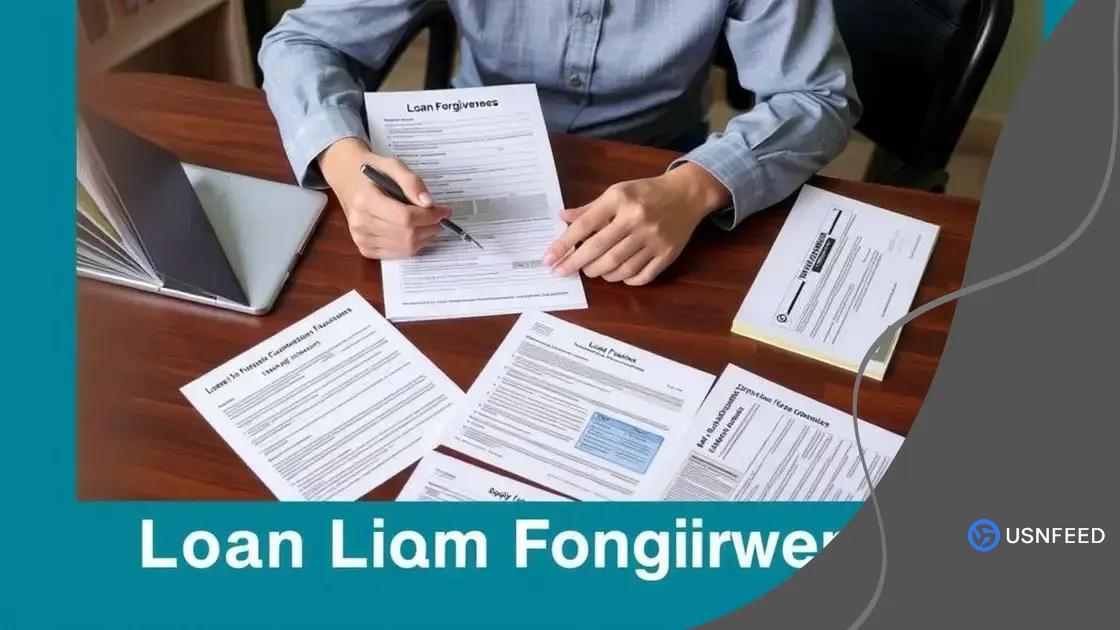Student loan forgiveness programs latest updates you need

Student loan forgiveness programs provide eligible borrowers the opportunity to reduce or eliminate their student debt through specific application processes, typically linked to public service or income-driven repayment plans.
Student loan forgiveness programs latest can be a game-changer for many borrowers. Have you ever wondered how you could ease your financial burden? Let’s dive into the opportunities and insights that these programs offer.
Understanding student loan forgiveness programs
Understanding student loan forgiveness programs can seem daunting at first, but it can provide significant relief for borrowers. These programs aim to reduce or eliminate student debt for eligible individuals working in specific fields or meeting other criteria. With the right information, you can navigate this process successfully.
What Are Student Loan Forgiveness Programs?
These programs allow borrowers to have a portion or all of their loan balance forgiven after meeting certain requirements. Many programs target public service workers, teachers, and healthcare professionals. Each program has its unique eligibility criteria and application processes.
Types of Forgiveness Programs
- Public Service Loan Forgiveness (PSLF) – Available for government and non-profit employees.
- Teacher Loan Forgiveness – For teachers in low-income schools.
- Income-Driven Repayment (IDR) Forgiveness – Forgiveness after a set repayment period based on income.
Additionally, some states offer their own forgiveness programs aimed at residents working in specific professions. It’s important to research programs available in your area, as they may provide options not covered by federal programs. As eligibility requirements vary, understanding each program can help you choose the right path.
An essential part of the process is ensuring you meet the terms outlined by the specific program. This could include making a certain number of qualifying payments or working in a designated field for a specific time. Keep in mind, applying for forgiveness can sometimes be complex and may require diligent tracking of your employment and loan payments.
When considering the various options, be sure to gather all necessary documentation and follow the application guidelines thoroughly. Utilizing resources from your loan servicer or educational institutions can provide guidance to help you prepare.
Eligibility criteria for loan forgiveness
Eligibility criteria for loan forgiveness can vary widely depending on the specific program you are interested in. Understanding these criteria is essential to determine if you qualify and what actions you need to take.
General Requirements
Most loan forgiveness programs require borrowers to meet certain basic criteria. This may include:
- Having eligible federal student loans.
- Being enrolled in an approved repayment plan.
- Making a specified number of qualifying payments.
- Working in a particular field or for specific employers.
Different programs have unique requirements, so it’s crucial to read the details carefully. For example, the Public Service Loan Forgiveness (PSLF) program specifically requires borrowers to work for government or non-profit organizations to qualify. Similarly, the Teacher Loan Forgiveness program has criteria that mandate teaching in low-income schools for a set duration.
Meeting these requirements can often involve documenting your employment and service history. It’s best to keep meticulous records, as you may need to submit this information during your application for forgiveness. Notably, some programs have time limits on when you must apply, so staying informed is essential.
Special Considerations
In addition to general criteria, some programs may require borrowers to meet special considerations. For instance, certain forgiveness options may apply to borrowers whose loans are in default or those affected by financial hardship. Understanding these nuances can help identify the best avenues for loan forgiveness.
As eligibility criteria often change, staying updated through official resources like the Federal Student Aid website can provide the latest information. You should also consider reaching out to your loan servicer for personalized advice and guidance tailored to your specific situation.
Step-by-step guide to apply for forgiveness

Applying for loan forgiveness can feel overwhelming, but a clear step-by-step guide will help simplify the process. Whether you are interested in the Public Service Loan Forgiveness program or another option, following a structured approach can lead to a successful application.
Step 1: Determine Your Eligibility
The first step is to ensure you meet the eligibility criteria for the specific forgiveness program you are interested in. Review the requirements closely, as they differ across programs.
Step 2: Gather Your Documents
Next, collect all necessary documentation. This usually includes:
- Your loan information and account details.
- Proof of employment or service.
- Payment history and records.
- Any relevant tax documents.
Having these documents ready will streamline your application process.
Step 3: Complete the Application
Once you have gathered your documents, complete the application form required for the forgiveness program. Ensure that all information is accurate and complete to avoid delays. If you’re applying for the PSLF, you will use the PSLF application, which must be submitted to your loan servicer.
Step 4: Submit Your Application
After completing your application, submit it according to the instructions provided. Pay attention to any deadlines and submission methods. Some applications may need to be mailed, while others can be submitted online.
Step 5: Follow Up
It is crucial to follow up after submission. Check the status of your application regularly and respond promptly to any requests for additional information. Your loan servicer may contact you for clarifications, so staying engaged during this time is essential.
Throughout this entire process, keep copies of all documents submitted and any correspondence with your loan servicer. This will help you manage your loan forgiveness application effectively.
Common challenges students face during the process
Many students face common challenges while navigating the loan forgiveness process. Understanding these hurdles can help you prepare and overcome obstacles effectively.
Documentation Issues
One significant challenge is gathering and submitting the correct documentation. Students may struggle to find necessary records, such as proof of employment or previous payment histories. Keeping organized records is essential, as missing documents can delay your application.
Complex Eligibility Criteria
The eligibility criteria for various programs can also be confusing. Some students may not fully understand whether they qualify for specific forgiveness options. It’s important to research and clarify any doubts directly with your loan servicer.
Miscommunication with Loan Servicers
Another challenge is miscommunication or lack of support from loan servicers. Sometimes, servicers provide unclear information or inconsistent advice, leading to frustration. Establishing open communication can mitigate these issues.
- Ask clearly defined questions.
- Request written confirmation of advice.
- Keep a record of all interactions.
Students also often face tight deadlines for applications or paperwork submissions. Missing these deadlines can lead to losing eligibility for forgiveness programs. Staying organized with a timeline of important dates is crucial.
Emotional Stress
Finally, the emotional stress involved in dealing with student loans cannot be ignored. Many students feel overwhelmed by the financial burden and the complexity of the forgiveness process. Seeking support from peers, family, or financial advisors can help ease this burden.
Understanding these challenges is the first step towards successfully navigating the loan forgiveness process. By being proactive and informed, you can better position yourself for success.
Recent changes and updates in forgiveness policies
Recent changes and updates in forgiveness policies have been significant and can impact many borrowers. Staying informed about these changes is crucial for anyone pursuing loan forgiveness.
Overview of Changes
In recent years, several forgiveness programs have undergone revisions to expand eligibility and streamline the application process. These updates aim to help more borrowers benefit from the financial relief they provide.
Changes in Eligibility Criteria
Many programs have relaxed their eligibility criteria. For instance, the Public Service Loan Forgiveness (PSLF) program has added more qualifying employers and made it easier for borrowers to certify their employment. This flexibility allows a broader range of public service workers to apply.
New Repayment Options
New repayment options have also been introduced. Income-driven repayment plans have become more accessible, providing borrowers with lower monthly payments based on their income. The revised terms can lead to a shorter path to forgiveness for those enrolled in these plans.
- Changes include capped monthly payments.
- Increased payment counting towards forgiveness.
- Enhanced support for borrowers with financial hardships.
Additionally, some loan servicers have improved their communication regarding forgiveness options. Many are now offering clearer guidance and more resources to help borrowers navigate the process effectively.
Impacts of Recent Legislative Changes
Recent legislative changes have also played a role in amplifying forgiveness opportunities. New bills aim to streamline processes, eliminate paperwork requirements, and ensure that borrowers do not miss out on eligible forgiveness due to administrative errors.
It is important for borrowers to regularly review their options in light of these updates. Staying connected with relevant news and official announcements from the Department of Education can help ensure you understand how changes affect your eligibility and application for forgiveness.
In summary, understanding the various aspects of student loan forgiveness programs is key to navigating this complex process. By knowing the eligibility requirements, application steps, and the latest updates in policies, borrowers can position themselves for success. Awareness of common challenges can also help students better prepare and seek support when needed. Remember to stay informed and proactive about your options to make the most of available resources and opportunities for forgiveness.
FAQ – Common Questions about Student Loan Forgiveness
What are the eligibility requirements for student loan forgiveness?
Eligibility varies by program but generally includes working in public service, having qualifying loan types, and meeting specific repayment terms.
How do I apply for loan forgiveness?
To apply, gather necessary documents, complete the application specific to your forgiveness program, and submit it to your loan servicer.
What challenges might I face during the forgiveness process?
Common challenges include gathering documentation, understanding complex eligibility criteria, and potential miscommunication with loan servicers.
Have there been recent changes to forgiveness policies?
Yes, recent updates have expanded eligibility and streamlined the application processes for several forgiveness programs.